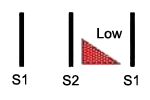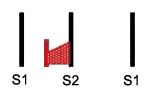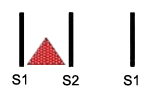
- Timing

- When do murmurs occur?
- Systole, Diastole
- Early or late in systole or diastole?
- Does it occur through out the heart cycle?
- Does the intensity of the sound
vary over time?
UNDERSTANDING CARDIAC MURMUR SONOGRAMS
- Sonogram is a graphical
depiction of sound
- The following sonogram depicts a mid-diastolic
decrescendo murmur
- The red area depicts the sound which occurs between S2 and S1 hence diastolic murmur
- The sound starts after S2 and ends before S1 hence a mid-diastolic murmur
- The sound starts loud and decreases hence a decrescendo murmur.
- The following sonogram depicts a pansystolic
murmur or holosystolic murmur
- Red area depicts sound which occurs between S1 and S2 hence a systolic" murmur
- The sound is pansystolic or holosystolic murmur
- The sound intensity does not vary throughout the murmur hence holosystolic
- The following sonogram depicts a late
systolic crescendo murmur with a midsystolic
click
- Red area depicts sound occurs between S1 and S2 hence a systolic murmur
- Sound begins in the middle of systole and ends with diastole hence a late systolic murmur
- Sound increases in intensity through the end of systole hence a crescendo murmur
- The sonogram depicts a spike mid-systole representing a midsystolic ejection click
- The following is a midsystolic
crescendo-decrescendo or diamond-shaped
murmur
- Red area depicts sound occurring between S1 and S2 hence a systolic murmur
- Sound begins after S1 and ends before S2 hence midsystolic
- Sound increases in intensity then decreases hence crescendo-decrescendo murmur
- This murmur is also known as a systolic ejection murmur




